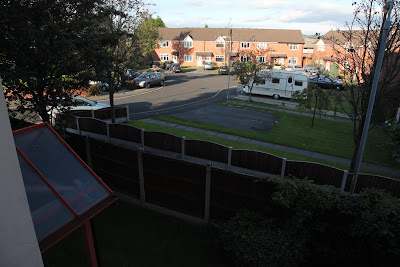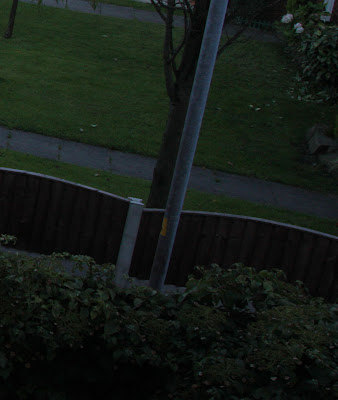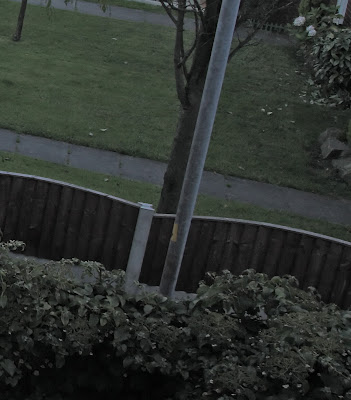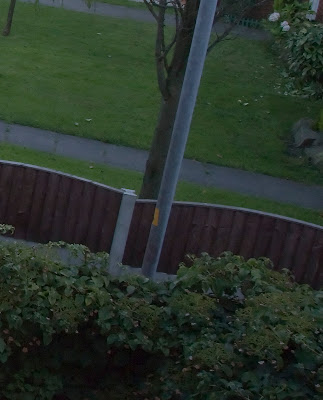In earlier experiments, I did not find much of an advantage to using RAW files, but mainly the disadvantage that they take up more disk space, and more time to open (and more expertise). So I have rarely used RAW.
But I did a casual experiment today with the Canon 5D2, and I'm beginning to see why I might want to take and keep the RAW files. Now, this was just pretty sloppy processing, and I know very little about it, but see:
A very contrasty scene. A problem for all cameras. The shadow areas are too dark, flat, and noisy.

Detail from the right edge, in the shadows:

The same area, corrected as well as I could with lifting the shadows, dampening noise, and sharpening... from the JPG file the camera made:

And the same area, only this time from the RAW file:
 Notice how the colors are better (the JPG had almost killed them), and there is more detail. (You need to click on them for the full-sized samples to really see it.)
Notice how the colors are better (the JPG had almost killed them), and there is more detail. (You need to click on them for the full-sized samples to really see it.)The contrast and micro-contrast seems poor perhaps, but remember: 1) this is a section of only the shade, and 2) it could easily be improved, this is just a quick-and-dirty experiment.
15 comments:
There is a good explanation of digital camera raw at
http://www.adobe.com/digitalimag/pdfs/understanding_digitalrawcapture.pdf
The main factor in trying to bring something up out of the shadows is the fact that jpg only uses 8 bits (256 steps) for tonal information per pixel for the entire photo. If the shadow area is only using 10% of that, then you only have 25 steps to use to try to expand the shadows. However, most raw formats use at least 12 bits (4096 steps) for tonal information per pixel, giving you over 400 steps per pixel in the lower 10% of the shadows. A lot more information for expanding the shadows.
Bob
Hey EO, don't you mean click for big pic (grin)
It's interesting, you're right about the color. But, look at the tree trunk (on the bigger image) right behind the metal pole. There seems to be more contrast and shows more detail in the jpg vs. the raw. Like, the roughness of the bark.
Bob R, could you please post that URL again. I tried copy/paste and that page wasn't found on the Adobe site..
Tommy, try here.
The detail contrast of the RAW version is on the low side, but I'm sure it could be a lot better, this was just a quick-and-dirty attempt by a rookie.
Here's the URL again. Works for me.
http://www.adobe.com/digitalimag/pdfs/understanding_digitalrawcapture.pdf
Bob
Hi Bob, just tried your link (both of 'em, actually) and I'm getting the same result as Tommy ... any ideas?
It's a link to a PDF file. Maybe a setting in your browser blocks it?
I tried EO's link and came up with this. Looks like there's stuff after the work understanding
http://www.adobe.com/digitalimag/pdfs
/understanding_digitalrawcapture.pdf
Concerning the examples: I thought that the difference would be more impressive. Actually the difference is much in the color, that could certainly be improved otherwise.
Where I imagine the great advantage of RAW file (and I have to learn how to make it) on JPEG is when you process a picture, export it, and then have another idea, and open it again, modify it again, and export it again. If it is JPEG, the program will recompress it each time, and that can alter the quality after a few rounds. I imagine that if the format stays RAW, the quality of the image will not be altered, am I right ?
Aniko said "I imagine that if the format stays RAW, the quality of the image will not be altered, am I right ?"
That's my understanding as well and it's a BIG problem with using jpegs if you want to edit it later.
Thanks Tommy !
It's true.
Also, the leeway with changes is much bigger with RAW.
But If you just use the pics just like they come from the camera, the difference in the formats is negligible.
[...] the JPG had almost killed them [...]
JPEG works on the assumption that the eye is way more sensitive to luminance variations than it is to chroma (color). So the preferred way of achieving a set compression goal is to reduce chroma dynamic range, while attempting to preserve luminance as much as possible...
I dont see the problem with jpgs getting recompressed, because you can save and work from the original, altho I prefer raw myself
Post a Comment